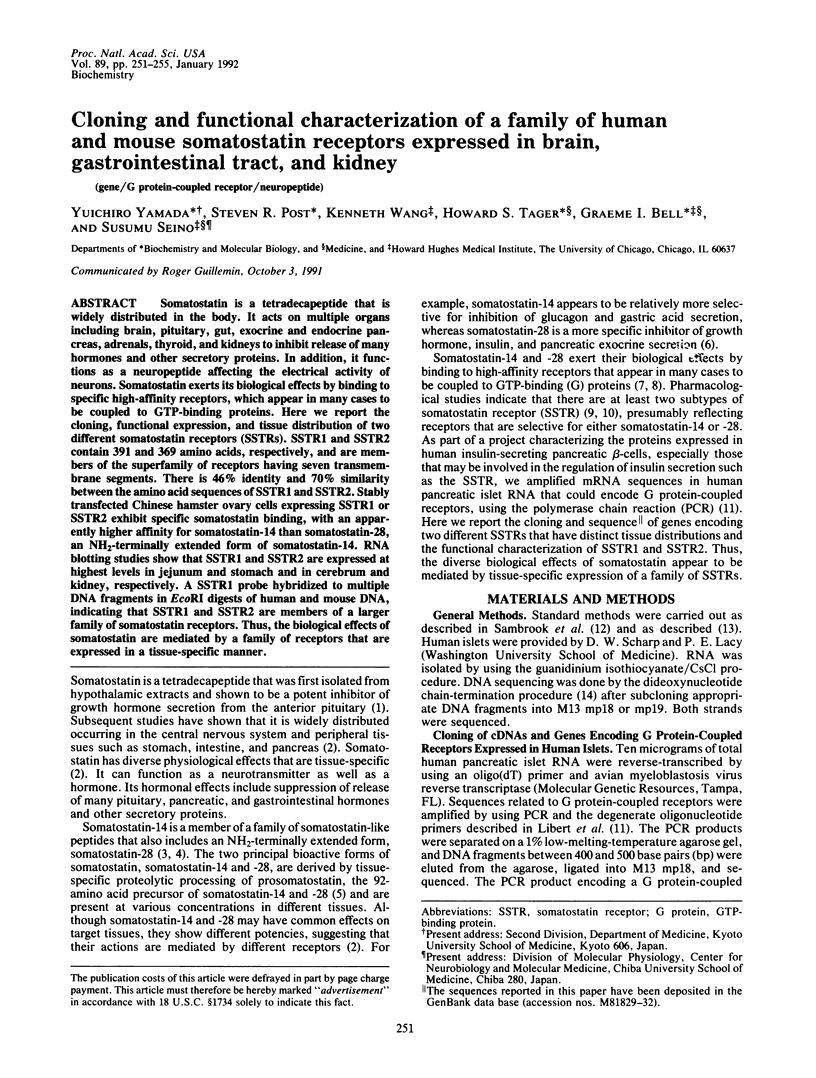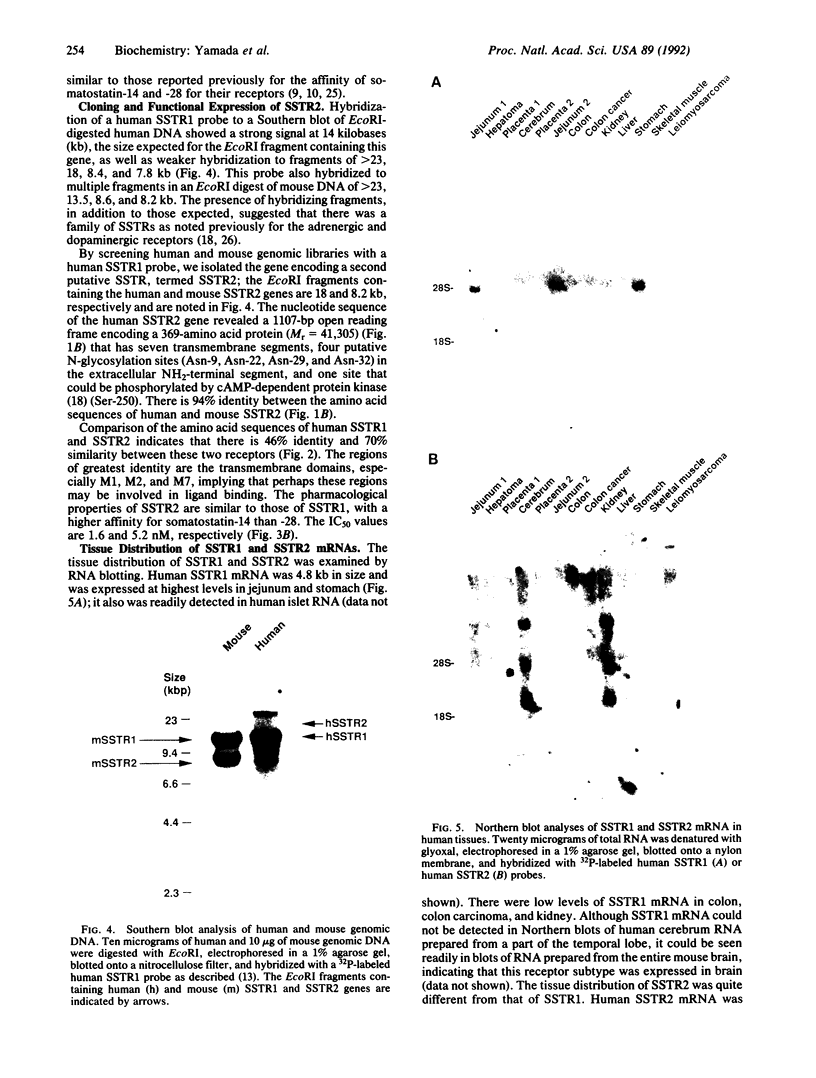Abstract
Somatostatin is a tetradecapeptide that is widely distributed in the body. It acts on multiple organs including brain, pituitary, gut, exocrine and endocrine pancreas, adrenals, thyroid, and kidneys to inhibit release of many hormones and other secretory proteins. In addition, it functions as a neuropeptide affecting the electrical activity of neurons. Somatostatin exerts its biological effects by binding to specific high-affinity receptors, which appear in many cases to be coupled to GTP-binding proteins. Here we report the cloning, functional expression, and tissue distribution of two different somatostatin receptors (SSTRs). SSTR1 and SSTR2 contain 391 and 369 amino acids, respectively, and are members of the superfamily of receptors having seven transmembrane segments. There is 46% identity and 70% similarity between the amino acid sequences of SSTR1 and SSTR2. Stably transfected Chinese hamster ovary cells expressing SSTR1 or SSTR2 exhibit specific somatostatin binding, with an apparently higher affinity for somatostatin-14 than somatostatin-28, and NH2-terminally extended form of somatostatin-14. RNA blotting studies show that SSTR1 and SSTR2 are expressed at highest levels in jejunum and stomach and in cerebrum and kidney, respectively. A SSTR1 probe hybridized to multiple DNA fragments in EcoRI digests of human and mouse DNA, indicating that SSTR1 and SSTR2 are members of a larger family of somatostatin receptors. Thus, the biological effects of somatostatin are mediated by a family of receptors that are expressed in a tissue-specific manner.
Full text
PDF




Images in this article
Selected References
These references are in PubMed. This may not be the complete list of references from this article.
- Brazeau P., Vale W., Burgus R., Ling N., Butcher M., Rivier J., Guillemin R. Hypothalamic polypeptide that inhibits the secretion of immunoreactive pituitary growth hormone. Science. 1973 Jan 5;179(4068):77–79. doi: 10.1126/science.179.4068.77. [DOI] [PubMed] [Google Scholar]
- Bunzow J. R., Van Tol H. H., Grandy D. K., Albert P., Salon J., Christie M., Machida C. A., Neve K. A., Civelli O. Cloning and expression of a rat D2 dopamine receptor cDNA. Nature. 1988 Dec 22;336(6201):783–787. doi: 10.1038/336783a0. [DOI] [PubMed] [Google Scholar]
- Dohlman H. G., Thorner J., Caron M. G., Lefkowitz R. J. Model systems for the study of seven-transmembrane-segment receptors. Annu Rev Biochem. 1991;60:653–688. doi: 10.1146/annurev.bi.60.070191.003253. [DOI] [PubMed] [Google Scholar]
- Dorflinger L. J., Schonbrunn A. Somatostatin inhibits basal and vasoactive intestinal peptide-stimulated hormone release by different mechanisms in GH pituitary cells. Endocrinology. 1983 Nov;113(5):1551–1558. doi: 10.1210/endo-113-5-1551. [DOI] [PubMed] [Google Scholar]
- Esch F., Böhlen P., Ling N., Benoit R., Brazeau P., Guillemin R. Primary structure of ovine hypothalamic somatostatin-28 and somatostatin-25. Proc Natl Acad Sci U S A. 1980 Nov;77(11):6827–6831. doi: 10.1073/pnas.77.11.6827. [DOI] [PMC free article] [PubMed] [Google Scholar]
- Findlay J., Eliopoulos E. Three-dimensional modelling of G protein-linked receptors. Trends Pharmacol Sci. 1990 Dec;11(12):492–499. doi: 10.1016/0165-6147(90)90050-i. [DOI] [PubMed] [Google Scholar]
- Fukumoto H., Seino S., Imura H., Seino Y., Eddy R. L., Fukushima Y., Byers M. G., Shows T. B., Bell G. I. Sequence, tissue distribution, and chromosomal localization of mRNA encoding a human glucose transporter-like protein. Proc Natl Acad Sci U S A. 1988 Aug;85(15):5434–5438. doi: 10.1073/pnas.85.15.5434. [DOI] [PMC free article] [PubMed] [Google Scholar]
- Kayano T., Burant C. F., Fukumoto H., Gould G. W., Fan Y. S., Eddy R. L., Byers M. G., Shows T. B., Seino S., Bell G. I. Human facilitative glucose transporters. Isolation, functional characterization, and gene localization of cDNAs encoding an isoform (GLUT5) expressed in small intestine, kidney, muscle, and adipose tissue and an unusual glucose transporter pseudogene-like sequence (GLUT6). J Biol Chem. 1990 Aug 5;265(22):13276–13282. [PubMed] [Google Scholar]
- Kayano T., Fukumoto H., Eddy R. L., Fan Y. S., Byers M. G., Shows T. B., Bell G. I. Evidence for a family of human glucose transporter-like proteins. Sequence and gene localization of a protein expressed in fetal skeletal muscle and other tissues. J Biol Chem. 1988 Oct 25;263(30):15245–15248. [PubMed] [Google Scholar]
- Kemp B. E., Pearson R. B. Protein kinase recognition sequence motifs. Trends Biochem Sci. 1990 Sep;15(9):342–346. doi: 10.1016/0968-0004(90)90073-k. [DOI] [PubMed] [Google Scholar]
- Kimura N., Hayafuji C., Kimura N. Characterization of 17-beta-estradiol-dependent and -independent somatostatin receptor subtypes in rat anterior pituitary. J Biol Chem. 1989 Apr 25;264(12):7033–7040. [PubMed] [Google Scholar]
- Kobilka B. K., Frielle T., Dohlman H. G., Bolanowski M. A., Dixon R. A., Keller P., Caron M. G., Lefkowitz R. J. Delineation of the intronless nature of the genes for the human and hamster beta 2-adrenergic receptor and their putative promoter regions. J Biol Chem. 1987 May 25;262(15):7321–7327. [PubMed] [Google Scholar]
- Lamberts S. W., Bakker W. H., Reubi J. C., Krenning E. P. Somatostatin-receptor imaging in the localization of endocrine tumors. N Engl J Med. 1990 Nov 1;323(18):1246–1249. doi: 10.1056/NEJM199011013231805. [DOI] [PubMed] [Google Scholar]
- Lawn R. M., Fritsch E. F., Parker R. C., Blake G., Maniatis T. The isolation and characterization of linked delta- and beta-globin genes from a cloned library of human DNA. Cell. 1978 Dec;15(4):1157–1174. doi: 10.1016/0092-8674(78)90043-0. [DOI] [PubMed] [Google Scholar]
- Lewis D. L., Weight F. F., Luini A. A guanine nucleotide-binding protein mediates the inhibition of voltage-dependent calcium current by somatostatin in a pituitary cell line. Proc Natl Acad Sci U S A. 1986 Dec;83(23):9035–9039. doi: 10.1073/pnas.83.23.9035. [DOI] [PMC free article] [PubMed] [Google Scholar]
- Libert F., Parmentier M., Lefort A., Dinsart C., Van Sande J., Maenhaut C., Simons M. J., Dumont J. E., Vassart G. Selective amplification and cloning of four new members of the G protein-coupled receptor family. Science. 1989 May 5;244(4904):569–572. doi: 10.1126/science.2541503. [DOI] [PubMed] [Google Scholar]
- Pradayrol L., Jörnvall H., Mutt V., Ribet A. N-terminally extended somatostatin: the primary structure of somatostatin-28. FEBS Lett. 1980 Jan 1;109(1):55–58. doi: 10.1016/0014-5793(80)81310-x. [DOI] [PubMed] [Google Scholar]
- Reichlin S. Somatostatin (second of two parts). N Engl J Med. 1983 Dec 22;309(25):1556–1563. doi: 10.1056/NEJM198312223092506. [DOI] [PubMed] [Google Scholar]
- Reisine T., Zhang Y. L., Sekura R. Pertussis toxin treatment blocks the inhibition of somatostatin and increases the stimulation by forskolin of cyclic AMP accumulation and adrenocorticotropin secretion from mouse anterior pituitary tumor cells. J Pharmacol Exp Ther. 1985 Jan;232(1):275–282. [PubMed] [Google Scholar]
- Ross E. M. Cellular signalling. Viral hijack of receptors. Nature. 1990 Apr 19;344(6268):707–708. doi: 10.1038/344707a0. [DOI] [PubMed] [Google Scholar]
- Sakamoto C., Nagao M., Matozaki T., Nishizaki H., Konda Y., Baba S. Somatostatin receptors on rat cerebrocortical membranes. Structural characterization of somatostatin-14 and somatostatin-28 receptors and comparison with pancreatic type receptors. J Biol Chem. 1988 Oct 5;263(28):14441–14445. [PubMed] [Google Scholar]
- Sanger F., Coulson A. R., Barrell B. G., Smith A. J., Roe B. A. Cloning in single-stranded bacteriophage as an aid to rapid DNA sequencing. J Mol Biol. 1980 Oct 25;143(2):161–178. doi: 10.1016/0022-2836(80)90196-5. [DOI] [PubMed] [Google Scholar]
- Schally A. V. Oncological applications of somatostatin analogues. Cancer Res. 1988 Dec 15;48(24 Pt 1):6977–6985. [PubMed] [Google Scholar]
- Schonbrunn A., Rorstad O. P., Westendorf J. M., Martin J. B. Somatostatin analogs: correlation between receptor binding affinity and biological potency in GH pituitary cells. Endocrinology. 1983 Nov;113(5):1559–1567. doi: 10.1210/endo-113-5-1559. [DOI] [PubMed] [Google Scholar]
- Shen L. P., Pictet R. L., Rutter W. J. Human somatostatin I: sequence of the cDNA. Proc Natl Acad Sci U S A. 1982 Aug;79(15):4575–4579. doi: 10.1073/pnas.79.15.4575. [DOI] [PMC free article] [PubMed] [Google Scholar]
- Sibley D. R., Benovic J. L., Caron M. G., Lefkowitz R. J. Regulation of transmembrane signaling by receptor phosphorylation. Cell. 1987 Mar 27;48(6):913–922. doi: 10.1016/0092-8674(87)90700-8. [DOI] [PubMed] [Google Scholar]
- Srikant C. B., Patel Y. C. Receptor binding of somatostatin-28 is tissue specific. Nature. 1981 Nov 19;294(5838):259–260. doi: 10.1038/294259a0. [DOI] [PubMed] [Google Scholar]
- Susini C., Bailey A., Szecowka J., Williams J. A. Characterization of covalently cross-linked pancreatic somatostatin receptors. J Biol Chem. 1986 Dec 15;261(35):16738–16743. [PubMed] [Google Scholar]
- Thermos K., Meglasson M. D., Nelson J., Lounsbury K. M., Reisine T. Pancreatic beta-cell somatostatin receptors. Am J Physiol. 1990 Aug;259(2 Pt 1):E216–E224. doi: 10.1152/ajpendo.1990.259.2.E216. [DOI] [PubMed] [Google Scholar]
- Tran V. T., Beal M. F., Martin J. B. Two types of somatostatin receptors differentiated by cyclic somatostatin analogs. Science. 1985 Apr 26;228(4698):492–495. doi: 10.1126/science.2858917. [DOI] [PubMed] [Google Scholar]
- Wang H. L., Bogen C., Reisine T., Dichter M. Somatostatin-14 and somatostatin-28 induce opposite effects on potassium currents in rat neocortical neurons. Proc Natl Acad Sci U S A. 1989 Dec;86(23):9616–9620. doi: 10.1073/pnas.86.23.9616. [DOI] [PMC free article] [PubMed] [Google Scholar]
- Williams J. A., McChesney D. J., Calayag M. C., Lingappa V. R., Logsdon C. D. Expression of receptors for cholecystokinin and other Ca2+-mobilizing hormones in Xenopus oocytes. Proc Natl Acad Sci U S A. 1988 Jul;85(13):4939–4943. doi: 10.1073/pnas.85.13.4939. [DOI] [PMC free article] [PubMed] [Google Scholar]





